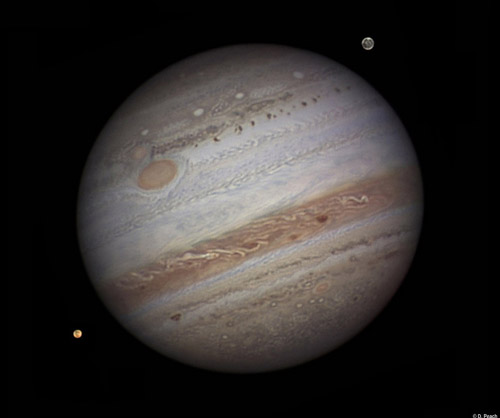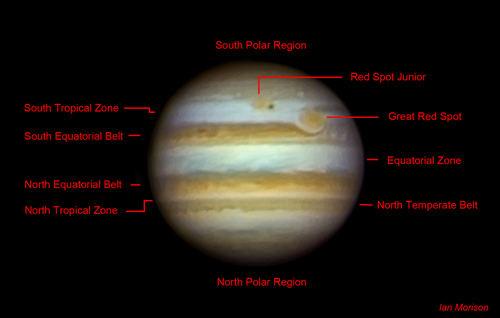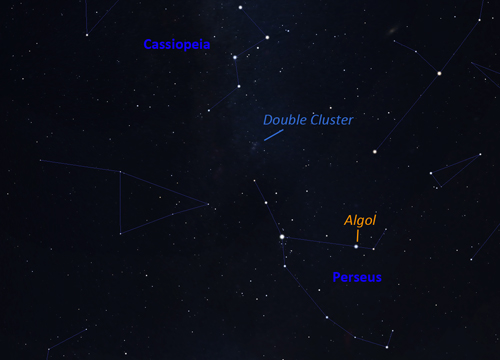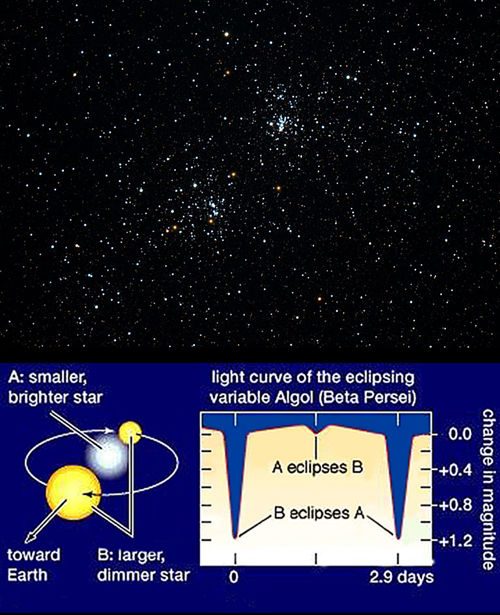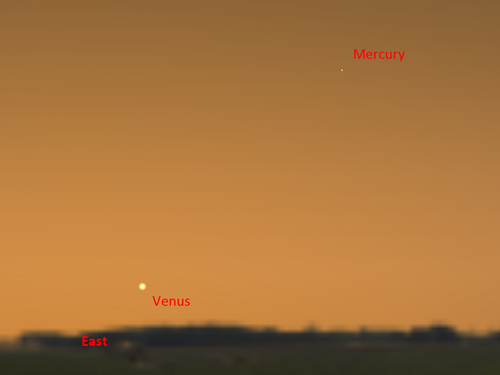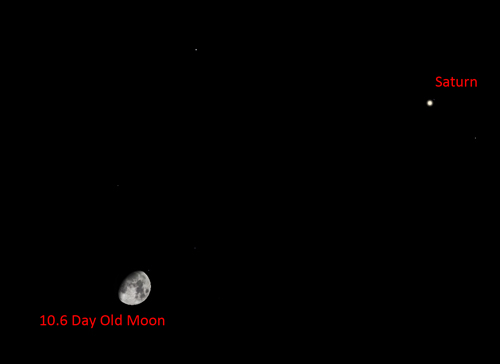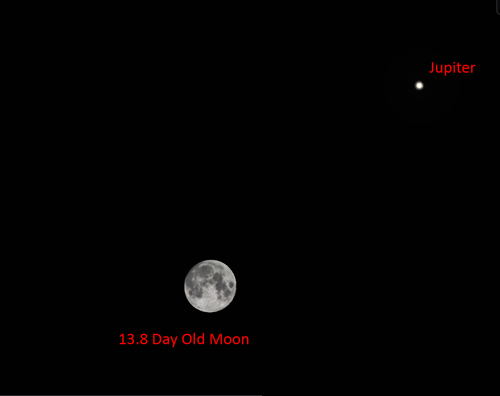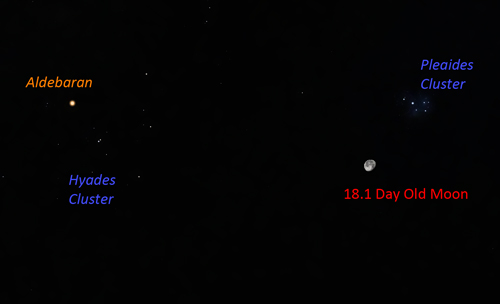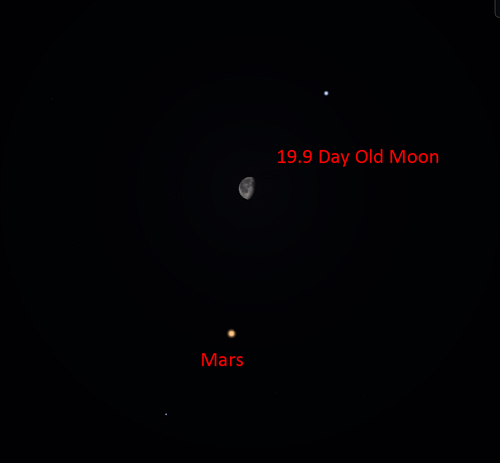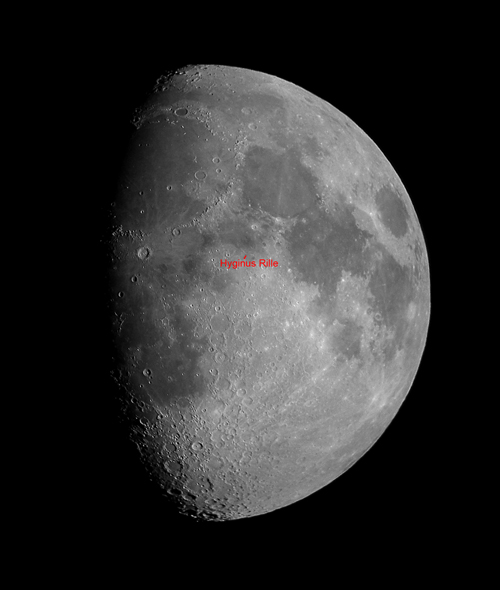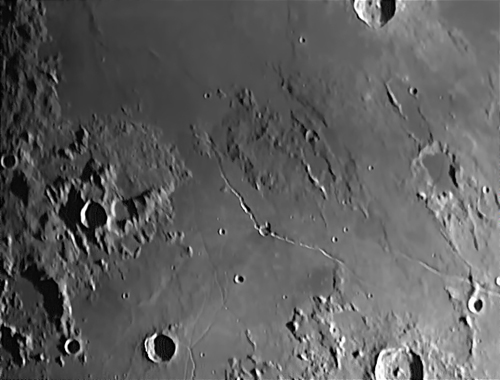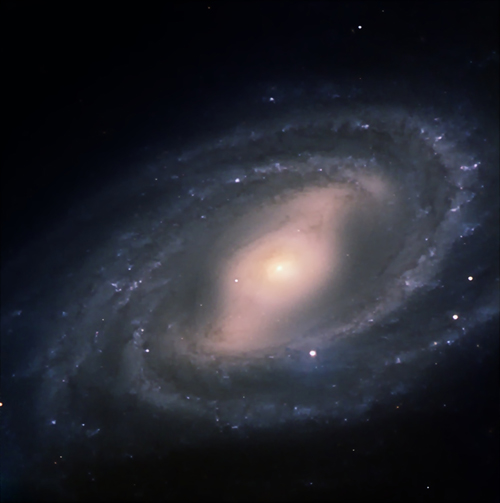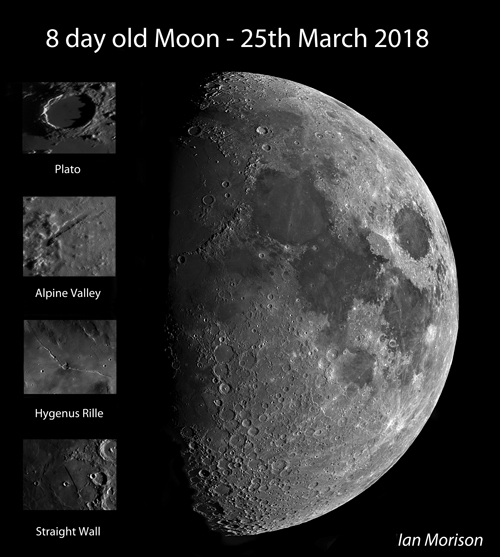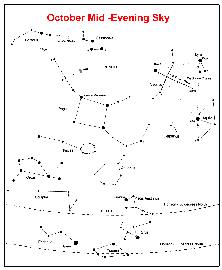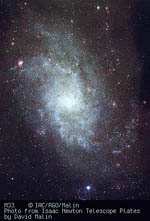Monthly Night Sky Guide October 2022
Compiled by Ian Morison
This page, updated monthly, will let you know some of the things that you can look out for in the night sky. It lists the phases of the Moon, where you will see the naked-eye planets and describes some of the prominent constellations in the night sky during the month.
New(ish)
The author's: Astronomy Digest
which, over time, will provide useful and, I hope, interesting articles for all amateur astronomers. A further aim is to update and add new material to link with the books recently published by Cambridge University Press and which are described on the home page of the digest. It now includes over 100 illustrated articles.Image of the Month
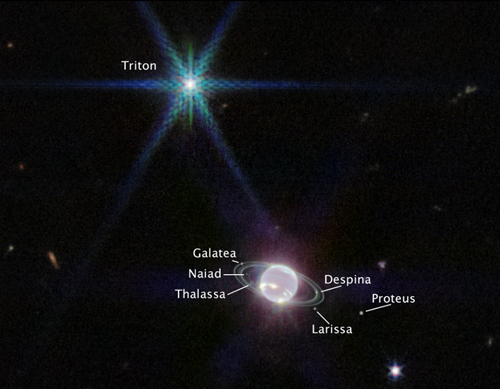
Neptune - James Webb Telescopes.
The James Webb Telescope has produced a beautiful image of Neptune using it Near-Infrared Camera (NIRCam). The methane gas in Neptune's atmosphere strongly absorbs red in infrared light, so the planet appears quite dark at the near-infrared wavelengths except where high altitude clouds are present which reflect sunlight before it is absorbed by methane gas. The James Webb Telescope has also captured seven of Neptune's known moons. the very bright 'star like' object at the upper left is Triton; covered in a frozen sheen of condensed nitrogen, it reflects ~70% of the Sun's light and far outshines Neptune at near-infrared wavelengths.
Highlights of the Month
October - a great month to view Jupiter.
This is a great month to observe Jupiter which will be visible during for much of the night having reached opposition on the 26th of September. It is now moving up the ecliptic and reaches an elevations of ~38 degrees when crossing the meridian. An interesting observation is that the Great Red Spot appears to be diminishing in size. At the beginning of the last century it spanned 40,000 km across but now appears to be only ~16,500 km across - less than half the size. It used to be said that 3 Earths could fit within it, but now it is only one. The shrinking rate appears to be accelerating and observations indicate that it is now reducing in size by ~580 miles per year. Will it eventually disappear?
The features seen in the Jovian atmosphere have been changing quite significantly over the last few years - for a while the South Equatorial Belt vanished completely (as seen in Damian's image) but has now returned to its normal wide state. The diagram on right shows the main Jovian features as imaged by the author at the beginning of December 2012. The image by Damian Peach was taken with a 14 inch telescope in Barbados where the seeing can be particularly good. This image won the "Astronomy Photographer of the Year" competition in 2011.See more of Damian Peach's images: Damian Peaches Website"
October, evening: the Double Cluster and the 'Demon Star', Algol.
This month is a good time to look high in the Southeast towards the constellations of Cassiopea and Perseus. Perseus contains two interesting objects; the Double Cluster between the two constellations and Algol the 'Demon Star'. Algol in an eclipsing binary system as seen in the diagram below. Normally the pair has a steady magnitude of 2.2 but every 2.86 days this briefly drops to magnitude 3.4.
October 1st - before dawn: Venus amd Mercury.
If clear for the first few days of the month, Mercury might be spotted up to the right of Venus. Binoculars may well be needed to cut through the Sun's glare - but please do not use them after the Sun has risen.
October 5th - evening: The Moon and Saturn.
Saturn will be seen, if clear, up to the right of a waxing Moon.
October 8th - evening: Jupiter and the Moon.
If clear, Jupiter will be seen to lie above the Moon, approching Full.
October 13th - evening: the Moon lies near the Hyades and Pleiades Clusters.
If clear, the Moon will be seen to lie close to the Hyades and Pleaides clusters.
October 15th - late evening: Mars and the Moon.
If clear, the Moon will be seen to lie above the planet Mars.
October 13th and 26th evening: the Hyginus Rille
For some time a debate raged as to whether the craters on the Moon were caused by impacts or volcanic activity. We now know that virtually all were caused by impact, but it is thought that the Hyginus crater that lies at the centre of the Hyginus Rille may well be volcanic in origin. It is an 11 km wide rimless pit - in contrast to impact craters which have raised rims - and its close association with the rille of the same name associates it with internal lunar events. It can quite easily be seen to be surrounded by dark material. It is thought that an explosive release of dust and gas created a vacant space below so that the overlying surface collapsed into it so forming the crater. On the evenings given above, the rille lies near the terminator.
M109 imaged with the Faulkes Telescope
The Galaxy M109, imaged by Daniel Duggan.
This image was taken using the Faulkes Telescope North by Daniel Duggan - for some time a member of the Faulkes telescope team. It shows the barred spiral galaxy M109 that lies at a distance of 83 million light years in the constellation of Ursa Major. It is the brightest galaxy in the Ursa Major group of some 50 galaxies. Our own Milky Way galaxy is now thought to be a barred spiral like M109.
Learn more about the Faulkes Telescopes and how schools can use them: Faulkes Telescope"
The Moon

The Moon at 3rd Quarter. Image, by Ian Morison, taken with a 150mm Maksutov-Newtonian and Canon G7.
Just below the crator Plato seen near the top of the image is the mountain "Mons Piton". It casts a long shadow across the maria from which one can calculate its height - about 6800ft or 2250m.
| new moon | first quarter | full moon | third quarter |
|---|---|---|---|
| October 25th | October 3rd | October 9th | October 17th |
Some Lunar Images by Ian Morison, Jodrell Bank Observatory: Lunar Images
A World Record Lunar Image
To mark International Year of Astronomy, a team of British astronomers have made the largest lunar image in history and gained a place in the Guinness Book of Records! The whole image comprises 87.4 megapixels with a Moon diameter of 9,550 pixels. The resolution of ~0.4 arc seconds allows details as small as 1km across to be discerned! The superb quality of the image is shown by the detail below of Plato and the Alpine Valley. Craterlets are seen on the floor of Plato and the rille along the centre of the Alpine valley is clearly visible. The image quality is staggering! The team of Damian Peach, Pete lawrence, Dave Tyler, Bruce Kingsley, Nick Smith, Nick Howes, Trevor Little, David Mason, Mark and Lee Irvine with technical support from Ninian Boyle captured the video sequences from which 288 individual mozaic panes were produced. These were then stitched together to form the lunar image.
Please follow the link to the Lunar World Record website and it would be really great if you could donate to Sir Patrick Moore's chosen charity to either download a full resolution image or purchase a print.
The 8 day old Moon
This image was taken by the author on a night in March 2018 when the Moon was at an elevation of ~52 degrees and the seeing was excellent. This enabled the resolution of the image to be largely determined by the resolution of the 200 mm aperture telescope and the 3.75 micron pixel size of the Point Grey Chameleon 1.3 megapixel video camera. The use of a near infrared filter allowed imaging to take place before it was dark and also reduced the effects of atmospheric turbulence. The 'Drizzle' technique developed by the Hubble Space Telescope Institute (HSTI) was used to reduce the effective size of the camera's pixels to allow the image to be well sampled. Around 100 gigabytes of data, acquired over a 2 hour period, was processed to produce images of 54 overlapping areas of the Moon which were then combined to give the full lunar disk in the free 'stitching' program Microsoft ICE. A further HSTI development called 'deconvolution sharpening' was then applied to the image. The Moon's disk is ~6,900 pixels in height and has a resolution of 0.6 to 0.7 arc seconds. Interestingly, as seen in the inset image, the rille lying along the centre of the Alpine Valley is just discernable and this is only ~0.5 km wide! [Due to size limitations the large image is 2/3 full size.]
The Planets
Jupiter
Jupiter. As darkness falls at the start of the month Jupiter is seen rising in the East, shining at magnitude -2.93 and having an angular size of 49.8 arc seconds. It reached opposition on the 26th of September and, with an elevation of 36 degrees at transit will be better seen than for a few years. By the end of the month, its magnitude will have dropped a little to -2.8 and its angular size to 48.5 arc seconds. The Great Red Spot may be seen around the following times (BST): 2nd 19:43, 4th 21:23, 6th 23:03, 9th 20:35, 11th 22:15, 13th 23:55 and 16th 21:27.
Saturn
Saturn, having reached opposition on the 14th of August, is seen in the south-east as darkness falls at the start of the month then having a magnitude of 0.5 and an angular size of 18 arc seconds with its rings spanning some 42 arc seconds across. It reaches an elevation of just 21 degrees as it then transits at 21:45 BST so, sadly, its low elevation will somewhat hinder our view of this most beautiful planet for some years to come. By month's end it transits at 18:47 GMT with a slightly reduced magnitude (0.66) and apparant size (17.2 arc seconds).
Mercury
Mercury. At the start of the month, and given a very low eastern horizon, Mercury might be spotted just before dawn up to the right of Venus. It will then have a magnitude of 1.29 and an angular size of 8.9 arc seconds. Over the next few days it will quicky rise in the eastern sky until it reaches greatest elongation on the 8th. Though then falling back towards the Sun, it will get brighter and will be easier to see - reaching a magnitude of -0.97 before it is lost in the Sun's glare by around the 18th of the month. Binoculars might well be needed to cut through the Sun's glare - but please do not use them after the Sun has risen.
Mars
Mars rises at 21:49 pm at the start of the month and can be seen well down to the left of Jupiter in the northeast having a magnitude of -0.6 and an angular size of 12 arc seconds. As the month progresses its magnitude increases to -1.25 with an angular size of 15 arc seconds. Under good seeing conditions, details on the surface should be seen - particularly by the end of the month when its elevation will reach ~61 degrees as it transits at 3 am GMT.
Venus
Venus can be seen very low in the East-Northeast in the pre-dawn sky at the start of the month having a magnitude of -3.93 and an angular size of 10 arc seconds. It is now moving towards superior conjunction with the Sun on October 22nd and, before long, will be lost in the Sun's glare. Binoculars might well be needed to spot it - but please do not use them after the Sun has risen.
The Stars
The Evening October Sky
This map shows the constellations seen towards the south in mid evening. To the south in early evening - moving over to the west as the night progresses is the beautiful region of the Milky Way containing both Cygnus and Lyra. Below is Aquilla. The three bright stars Deneb (in Cygnus), Vega (in Lyra) and Altair (in Aquila) make up the "Summer Triangle". East of Cygnus is the great square of Pegasus - adjacent to Andromeda in which lies M31, the Andromeda Nebula. To the north lies "w" shaped Cassiopeia with Perseus below.
The constellations Lyra and Cygnus
This month the constellations Lyra and Cygnus are seen almost overhead as darkness falls with their bright stars Vega, in Lyra, and Deneb, in Cygnus, making up the "summer triangle" of bright stars with Altair in the constellation Aquila below. (see sky chart above)
Lyra
Lyra is dominated by its brightest star Vega, the fifth brightest star in the sky. It is a blue-white star having a magnitude of 0.03, and lies 26 light years away. It weighs three times more than the Sun and is about 50 times brighter. It is thus burning up its nuclear fuel at a greater rate than the Sun and so will shine for a correspondingly shorter time. Vega is much younger than the Sun, perhaps only a few hundred million years old, and is surrounded by a cold,dark disc of dust in which an embryonic solar system is being formed!
There is a lovely double star called Epsilon Lyrae up and to the left of Vega. A pair of binoculars will show them up easily - you might even see them both with your unaided eye. In fact a telescope, provided the atmosphere is calm, shows that each of the two stars that you can see is a double star as well so it is called the double double!
Between Beta and Gamma Lyra lies a beautiful object called the Ring Nebula. It is the 57th object in the Messier Catalogue and so is also called M57. Such objects are called planetary nebulae as in a telescope they show a disc, rather like a planet. But in fact they are the remnants of stars, similar to our Sun, that have come to the end of their life and have blown off a shell of dust and gas around them. The Ring Nebula looks like a greenish smoke ring in a small telescope, but is not as impressive as it is shown in photographs in which you can also see the faint central "white dwarf" star which is the core of the original star which has collapsed down to about the size of the Earth. Still very hot this shines with a blue-white colour, but is cooling down and will eventually become dark and invisible - a "black dwarf"! Do click on the image below to see the large version - its wonderful!
M56 is an 8th magnitude Globular Cluster visible in binoculars roughly half way between Alberio (the head of the Swan) and Gamma Lyrae. It is 33,000 light years away and has a diameter of about 60 light years. It was first seen by Charles Messier in 1779 and became the 56th entry into his catalogue.
Cygnus
Cygnus, the Swan, is sometimes called the "Northern Cross" as it has a distinctive cross shape, but we normally think of it as a flying Swan. Deneb,the arabic word for "tail", is a 1.3 magnitude star which marks the tail of the swan. It is nearly 2000 light years away and appears so bright only because it gives out around 80,000 times as much light as our Sun. In fact if Deneb where as close as the brightest star in the northern sky, Sirius, it would appear as brilliant as the half moon and the sky would never be really dark when it was above the horizon!
The star, Albireo, which marks the head of the Swan is much fainter, but a beautiful sight in a small telescope. This shows that Albireo is made of two stars, amber and blue-green, which provide a wonderful colour contrast. With magnitudes 3.1 and 5.1 they are regarded as the most beautiful double star that can be seen in the sky.
Cygnus lies along the line of the Milky Way, the disk of our own Galaxy, and provides a wealth of stars and clusters to observe. Just to the left of the line joining Deneb and Sadr, the star at the centre of the outstretched wings, you may, under very clear dark skys, see a region which is darker than the surroundings. This is called the Cygnus Rift and is caused by the obscuration of light from distant stars by a lane of dust in our local spiral arm. the dust comes from elements such as carbon which have been built up in stars and ejected into space in explosions that give rise to objects such as the planetary nebula M57 described above.
There is a beautiful region of nebulosity up and to the left of Deneb which is visible with binoculars in a very dark and clear sky. Photographs show an outline that looks like North America - hence its name the North America Nebula. Just to its right is a less bright region that looks like a Pelican, with a long beak and dark eye, so not surprisingly this is called the Pelican Nebula. The photograph below shows them well.
Brocchi's Cluster An easy object to spot with binoculars in Gygnus is "Brocchi's Cluster", often called "The Coathanger",although it appears upside down in the sky! Follow down the neck of the swan to the star Alberio, then sweep down and to its lower left. You should easily spot it against the dark dust lane behind.
The constellations Pegasus and Andromeda
Pegasus
The Square of Pegasus is in the south during the evening and forms the body of the winged horse. The square is marked by 4 stars of 2nd and 3rd magnitude, with the top left hand one actually forming part of the constellation Andromeda. The sides of the square are almost 15 degrees across, about the width of a clentched fist, but it contains few stars visibe to the naked eye. If you can see 5 then you know that the sky is both dark and transparent! Three stars drop down to the right of the bottom right hand corner of the square marked by Alpha Pegasi, Markab. A brighter star Epsilon Pegasi is then a little up to the right, at 2nd magnitude the brightest star in this part of the sky. A little further up and to the right is the Globular Cluster M15. It is just too faint to be seen with the naked eye, but binoculars show it clearly as a fuzzy patch of light just to the right of a 6th magnitude star.
Andromeda
The stars of Andromeda arc up and to the left of the top left star of the square, Sirra or Alpha Andromedae. The most dramatic object in this constellation is M31, the Andromeda Nebula. It is a great spiral galaxy, similar to, but somewhat larger than, our galaxy and lies about 2.5 million light years from us. It can be seen with the naked eye as a faint elliptical glow as long as the sky is reasonably clear and dark. Move up and to the left two stars from Sirra, these are Pi amd Mu Andromedae. Then move your view through a rightangle to the right of Mu by about one field of view of a pair of binoculars and you should be able to see it easily. M31 contains about twice as many stars as our own galaxy, the Milky Way, and together they are the two largest members of our own Local Group of about 3 dozen galaxies.
M33 in Triangulum
If, using something like 8 by 40 binoculars, you have seen M31 as described above, it might well be worth searching for M33 in Triangulum. Triangulum is
the small faint constellation just below Andromeda. Start on M31, drop down to Mu Andromedae and keep on going in the same direction by the same distance as you have moved from M31 to Mu Andromedae. Under excellent seeing conditions (ie., very dark and clear skies) you should be able to see what looks like a little piece of tissue paper stuck on the sky or a faint cloud. It appears to have uniform brightness and shows no structure. The shape is irregular in outline - by no means oval in shape and covers an area about twice the size of the Moon. It is said that it is just visible to the unaided eye, so it the most distant object in the Universe that the eye can see. The distance is now thought to be 3.0 Million light years - just greater than that of M31.


